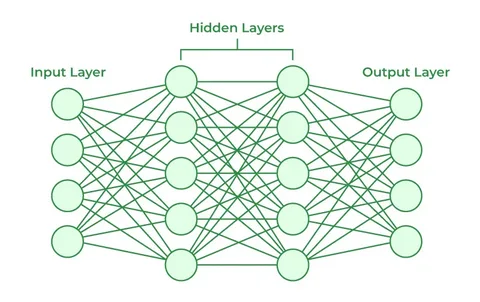Learn how to build neural networks from scratch with this beginner-friendly guide. Discover key concepts, steps, tools, and best practices for success.
Introduction
Neural networks are the backbone of modern artificial intelligence (AI) and machine learning (ML). From powering voice assistants to enabling advanced image recognition, these systems mimic how the human brain processes information. If you’ve ever wondered how to build neural networks, you’re not alone. The good news is that with the right approach, tools, and understanding of core concepts, creating your own neural network is both achievable and rewarding.
In this article, we’ll walk through the fundamentals of neural networks, the step-by-step process of building one, the tools you’ll need, and best practices to maximize performance.

What is a Neural Network?
A neural network is a machine learning model inspired by the human brain. It consists of layers of interconnected nodes (neurons) that process data. Each neuron receives input, applies a weight, passes it through an activation function, and sends the result to the next layer.
- Input Layer: Receives raw data (e.g., image pixels, text, numbers).
- Hidden Layers: Perform transformations and extract patterns.
- Output Layer: Produces the final prediction or classification.
This layered architecture allows neural networks to solve complex tasks such as natural language processing, computer vision, and predictive analytics.
Why Learn to Build Neural Networks?
Before jumping into the technical steps, it’s important to understand the benefits:
- Hands-On AI Skills – Gain practical experience beyond theory.
- Career Growth – Neural networks are in high demand across industries.
- Problem Solving – Build models that can recognize speech, detect fraud, or even recommend products.
- Innovation Opportunities – Develop unique AI-powered applications.
For instance, companies like Google and Meta rely heavily on neural networks to improve search, recommendation systems, and language translation (source).
Step-by-Step Guide: How to Build Neural Networks
1. Define the Problem
Start by identifying what your neural network should solve. Common problems include:
- Classification (e.g., spam vs. non-spam emails)
- Regression (predicting house prices)
- Clustering (grouping similar customer behaviors)
2. Collect and Prepare Data
Your neural network is only as good as the data you feed it.
- Gather a large, clean dataset relevant to your problem.
- Split the dataset into training (70%), validation (15%), and testing (15%) sets.
- Normalize or scale values to improve training performance.
👉 For tips on finding quality datasets, check our guide on best datasets for machine learning.
3. Choose the Right Framework
Several frameworks make building neural networks easier:
- TensorFlow (by Google)
- PyTorch (by Meta)
- Keras (high-level API for TensorFlow)
These tools provide pre-built functions for layers, activation functions, and optimization algorithms, saving you time.
4. Design the Network Architecture
Key decisions include:
- Number of Layers: More layers = more complexity (deep learning).
- Number of Neurons per Layer: Balancing performance and computation cost.
- Activation Functions: Such as ReLU, Sigmoid, or Tanh.
Example:
- Input Layer → 128 neurons → ReLU
- Hidden Layer → 64 neurons → ReLU
- Output Layer → Softmax (for classification tasks)
5. Compile the Model
Before training, define:
- Loss Function (e.g., cross-entropy for classification).
- Optimizer (e.g., Adam, SGD).
- Evaluation Metrics (e.g., accuracy, precision).
6. Train the Model
- Use backpropagation to update weights.
- Choose a suitable batch size and number of epochs.
- Monitor performance on validation data to avoid overfitting.
7. Evaluate the Model
After training, test the model on unseen data. Key evaluation metrics include:
- Accuracy
- Precision & Recall
- F1-Score
- Confusion Matrix
👉 For deeper insights into metrics, explore our article on machine learning model evaluation methods.
8. Fine-Tune and Deploy
- Adjust hyperparameters (learning rate, dropout rate).
- Use regularization techniques like L1/L2 regularization or dropout.
- Deploy the model with tools like TensorFlow Serving or Flask API for integration.
Best Practices for Building Neural Networks
- Start Simple: Use smaller architectures before moving to deep networks.
- Monitor Overfitting: Apply early stopping if validation loss increases.
- Use GPU Acceleration: Training large networks is faster with GPUs.
- Document Everything: Keep track of architectures, parameters, and results.
- Leverage Pre-Trained Models: Use transfer learning to save time and resources.
Common Mistakes to Avoid
- Using insufficient data (leading to poor accuracy).
- Ignoring data preprocessing.
- Choosing the wrong activation function.
- Overfitting by using too many layers.
- Not tuning hyperparameters.
Tools and Resources for Beginners
- Google Colab – Free cloud-based Jupyter notebooks with GPU support.
- Kaggle – Datasets and competitions to practice.
- Scikit-learn – Useful for preprocessing and simpler ML tasks.
- Coursera & edX Courses – Learn from top universities.
For additional learning, check out how to implement machine learning algorithms for a step-by-step coding perspective.

Conclusion
Building neural networks may seem intimidating at first, but with structured steps and the right tools, it becomes a manageable and highly rewarding skill. By defining your problem, preparing data carefully, designing the architecture, training, and evaluating performance, you can create models capable of solving real-world challenges.
Whether you’re a beginner or looking to advance your AI skills, the key is practice and experimentation. The more networks you build, the better you’ll understand how they learn and adapt.
